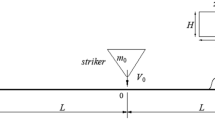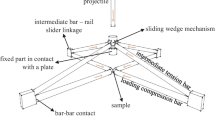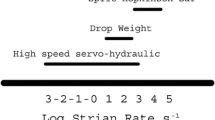Abstract
A complete three-dimensional FEM model of the Bar-Bar Tensile Impact Apparatus (BTIA) is constructed, in which the slots in the bars and the glue layers between the bars and the flat-shaped specimen are included. For elastic-plastic specimen material, Ly12cz aluminum alloy, the process of tensile impact experiments is simulated and the matching relation between the specimen geometry and the bars is investigated. Based on the FEM analysis, an iterative method is proposed to design a reasonable specimen geometry for obtaining the true dynamic stress-strain relation for a certain specimen material.
Similar content being viewed by others
References
Kolsky H. An investigation of the mechanical properties of materials at very high rates of loading. In: Proc Phys Soc (London) Ser. B, 62, 1949. 676–700
Harding J, et al. Impact Testing of Fiber-Reinforced Composite Materials. In: Proc ICCM-IV, Tokyo, 1982. 845
Xia YM, et al. Rotating disk bar-bar tensile impact test apparatus and its experimental technique. In: Science and Technology Achievement Appraisal, vol. 92. National Natural Science Foundation of China, 1992
Xia YM, Yang BC, Jia DX, Dong LM. Pendulum bar-bar tensile impact test apparatus and dynamic technique of measuring low temperature.Journal of Experimental Mechanics, 1989, 4: 57–66
Xia YM, Wang X, Yang BC. Constitutive equation for unidirectional composites under tensile impact.Composites Science and Technology, 1996, 56: 155–160
Bertholf LD. Feasibility of two dimensional numerical analysis of the Split-Hopkinson Pressure Bar System.Journal of Applied Mechanics, 1974: 137–144
Bertholf LD, Karnes CH. Two-dimensional analysis of the Split Hopkinson Pressure Bar System.J Mech Phys Solids, 1975, 23: 1–19
Wang Y, Xia YM. The proof of one-dimensional experimental principle for Bar-Bar Tensile Impact Apparatus.Journal of Experimental Mechanics, 1997, 3: 126–134
Wang CY, Xia YM. Two-dimensional finite element analysis of elastic wave propagation in cylindrical bars with interfaces.Journal of China University of Science and Technology, 1996, 26: 64–69
Wang CY, Wan HP, Xia YM. A two-dimensional axissymmetric numerical analysis of a Bar-Bar Tensile Impact Apparatus by elastoplastic FEM.Journal of Sound and Vibration, 1999, 220(5): 787–806
Wang CY, Xia YM. Validity of one-dimensional experimental principle for flat specimen in Bar-Bar Tensile Impact Apparatus.International Journal of Solids and Structures, 2000, 37: 3305–3322
Author information
Authors and Affiliations
Additional information
The project supported by the National Natural Science Foundation of China (19272061)
Rights and permissions
About this article
Cite this article
Huapei, W., Yang, W. & Yuanming, X. A complete three-dimensional finite element analysis of the bar-bar tensile impact apparatus. Acta Mech Sinica 19, 154–161 (2003). https://doi.org/10.1007/BF02487677
Received:
Revised:
Issue Date:
DOI: https://doi.org/10.1007/BF02487677




